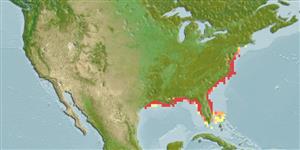Environment: milieu / climate zone / depth range / distribution range
Ecology
Marine; pelagic-neritic; depth range 3 - 15 m (Ref. 27549). Subtropical; 41°N - 24°N, 96°W - 71°W
Western Atlantic: New York and northern Gulf of Mexico to Florida in USA and northern Mexico.
Size / Weight / Age
Maturity: Lm ? range ? - ? cm
Max length : 12.5 cm TL male/unsexed; (Ref. 7251)
Occurs along shore and in bays and inlets.
Life cycle and mating behavior
Maturity | Reproduction | Spawning | Eggs | Fecundity | Larvae
Robins, C.R. and G.C. Ray, 1986. A field guide to Atlantic coast fishes of North America. Houghton Mifflin Company, Boston, U.S.A. 354 p. (Ref. 7251)
IUCN Red List Status (Ref. 130435: Version 2024-1)
Threat to humans
Harmless
Human uses
Fisheries: commercial
Tools
Special reports
Download XML
Internet sources
Estimates based on models
Preferred temperature (Ref.
123201): 12.8 - 26.1, mean 23.5 °C (based on 147 cells).
Phylogenetic diversity index (Ref.
82804): PD
50 = 0.5156 [Uniqueness, from 0.5 = low to 2.0 = high].
Bayesian length-weight: a=0.00550 (0.00248 - 0.01216), b=3.09 (2.90 - 3.28), in cm total length, based on LWR estimates for this (Sub)family-body shape (Ref.
93245).
Trophic level (Ref.
69278): 3.2 ±0.2 se; based on size and trophs of closest relatives
Resilience (Ref.
120179): High, minimum population doubling time less than 15 months (Preliminary K or Fecundity.).
Fishing Vulnerability (Ref.
59153): Low vulnerability (10 of 100).
Nutrients (Ref.
124155): Calcium = 247 [142, 526] mg/100g; Iron = 2.24 [1.27, 3.83] mg/100g; Protein = 19 [17, 22] %; Omega3 = 0.336 [0.146, 0.888] g/100g; Selenium = 15.1 [6.8, 35.4] μg/100g; VitaminA = 27.3 [8.5, 88.0] μg/100g; Zinc = 1.29 [0.86, 1.93] mg/100g (wet weight);
